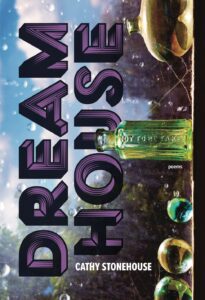‘Winter is by far the oldest season’
Dream House
by Cathy Stonehouse
Gibsons: Nightwood Editions, 2023
$19.95 / 9780889714625
Reviewed by Joe Enns
*

Dream House is the third book of poetry by Vancouver writer Cathy Stonehouse (The Causes) and in it she writes, “roads that cross water must be felt, not seen.” This passage illustrates perfectly the experience of reading this book, which is described as a long poem in six sections (with most pages containing seemingly stand-alone poems). The pieces carry the reader across distances, yet the passage is blurry and disorienting—in the way of a foot travelling from cobble to cobble underwater.
Self-referentially, Stonehouse writes of a poem as “syllables spliced into hedgerows, between which spirits river-drift.” Stonehouse creates collages, often stacking imagery in a personal, idiosyncratic procession that allows the reader to leap to their own meanings. While the specific context may be difficult to fully grasp, Stonehouse succeeds in conveying a complex and disordered feeling that aligns appropriately with the topics of identity and aging. That complexity may explain why Dream House was short-listed for the Dorothy Livesay Poetry Award in 2024.
Life is a dream. Poems, like the body, are rooms or shells in which to escape. Dream House portrays the human experience as one of transitory context and shifting identity (“who will she be / when she’s not where she is?”). Stonehouse interrogates the nature of the self (“your brief signature”), and questions where the “you” resides when the mind fades from the soul: “you are home; you are not home.”
This ethereal notion permeates Dream House in content, theme, and form, which Stonehouse approaches from a matrilineal perspective representing the lived experience as a multiverse of matriarchal heritage. The entire book is written in second person as though Stonehouse is writing to herself, creating a duplication effect for the speaker. This echoing fits well with Stonehouse’s analogous depiction of motherhood as a doubling (“your other face”). Caring for someone, a child or the elderly, often means doing the same things as them—the same place and the same time—and observing the same details as though their experience becomes your experience. Stonehouse wonders, “Is this her life, or yours?” In the second section, A Recipe for Trifle, Stonehouse references the song “And Her Mother Came Too” by Ivor Novello, which drives home the point that wherever we go, we carry our mothers with us.

Stonehouse asks, “Where does a figure eight begin?” The two circles of a figure eight—like two frames or two holes—also make one shape, which Stonehouse utilizes as an overarching metaphor (“your old thoughts, laid end to end”). The poems create an impression of a spiral through history and landscape, but also a limbo similar to the “the eerie greenness / of a cul-de-sac.” The cul-de-sac also works well as a related metaphor: a round gap resembling half a figure eight where you might pull a U-turn surrounded by houses in a colonial suburban construction.
The poetic form of Dream House is as ambiguous as the content. Each page finds its own form like “a wildflower trapped in a frame.” Stonehouse resists poetic devices, avoiding resonances of sound and rhythm in the words, relying more on the message. The arrangement becomes a collection of aesthetic choices, resulting in weak line breaks and inconsistent line lengths (some short, some very long) lacking apparent pattern.
Stonehouse seems to reference the poetic process in, Hymnal, the sixth section, where she writes of “finding form, even when there is none.” However, while Stonehouse mostly incorporates full complete sentences and proper punctuation, she uses a repeating device: the lack of full-stops at the end of each poem on a page. This noticeable omission emphasizes Stonehouse’s cul-de-sac or figure eight depicting the poems as a never-ending hallway of rooms: “walls are here, as are windows, symbolized / by the dot on the top of each i.” The language becomes spatial and temporal, blurring at once between frames (“what matters most when conjugating absence / is to separate present from past”).
As a reader, I found it difficult to read Dream House without applying my own family context over Stonehouse’s words. Dementia and Alzheimer’s disease rates are rising dramatically worldwide, and my family is no exception. While Stonehouse doesn’t reference care homes or dementia specifically, these poems conjured recent images of my experiences with dementia patients at a senior’s village (“inside, there are long rooms— / empty, full of the shells of older women”). Alzheimer’s patients lose track of time, not just the present, but the future, and seem to be lost in the past. My father in-law, always a health fanatic and salad enthusiast, suddenly began shaving his beard and eating hotdogs as when he was a teenager.
Dream House poignantly captures this feeling of vertigo, resembling an irreversible living dream where “there are no doorways / into the long rooms. They echo / instead with the rattle of distant theme / tunes.” Old age is sometimes described as the winter of our lives and Stonehouse approaches this another way when she writes, “winter is by far the oldest season,” a line adapted from Gaston Bachelard’s The Poetics of Space. She also quotes Bachelard in the epigraph, which works well to introduce the core theme of the book: an identity slowly withdrawing into a shell as an escape.
Aging and death are topics that affect us all and subliminally underpin our identities at every turn. Stonehouse depicts death as a slow transition rather than a finality, comparable to a dream: “one long, last breath, then another, no pause between,” like a poem lacking a period. Dreams create gaps in context (“your abandoned skin / still breathes”), and Stonehouse explores these spaces.
How to portray a room that is mostly filled with empty space? Describe the walls. Stonehouse lets the reader fill in the rest. In these poems as rooms, Stonehouse finds an escape through voice (“how to transcribe what was never said”), in the way our voices project us out into the world: “tried out voices until one spoke, / projected me.” Dream House is a compelling collage of language that resists the context of time and space to express the matrilineal connection as a shifting identity eternally spiralling through husks of bodies and pages to find an escape through the darkness.
*

Joe Enns is a writer, painter, and fisheries biologist on Vancouver Island. His writing has appeared in The Dalhousie Review, FreeFall, The Fiddlehead, GUSTS, and Portal Magazine, and book reviews in The Malahat Review and The British Columbia Review. Joe has a BA in Creative Writing and a BSc in Ecological Restoration. [Editor’s note: Joe has reviewed Clint Burnham, Nadine Sander-Green, Spenser Smith, Rodney DeCroo, Barbara Pelman, Karl Meade, M.W. Jaeggle, Ali Blythe, Emily Osborne, Will Goede, and Evelyn Lau for BCR.]
*
The British Columbia Review
Interim Editors, 2023-25: Trevor Marc Hughes (nonfiction), Brett Josef Grubisic (fiction and poetry)
Publisher: Richard Mackie
Formerly The Ormsby Review, The British Columbia Review is an online book review and journal service for BC writers and readers. The Advisory Board now consists of Jean Barman, Wade Davis, Robin Fisher, Barry Gough, Hugh Johnston, Kathy Mezei, Patricia Roy, Maria Tippett, and Graeme Wynn. Provincial Government Patron (since September 2018): Creative BC. Honorary Patron: Yosef Wosk. Scholarly Patron: SFU Graduate Liberal Studies. The British Columbia Review was founded in 2016 by Richard Mackie and Alan Twigg.
“Only connect.” – E.M. Forster
2 comments on “‘Winter is by far the oldest season’”